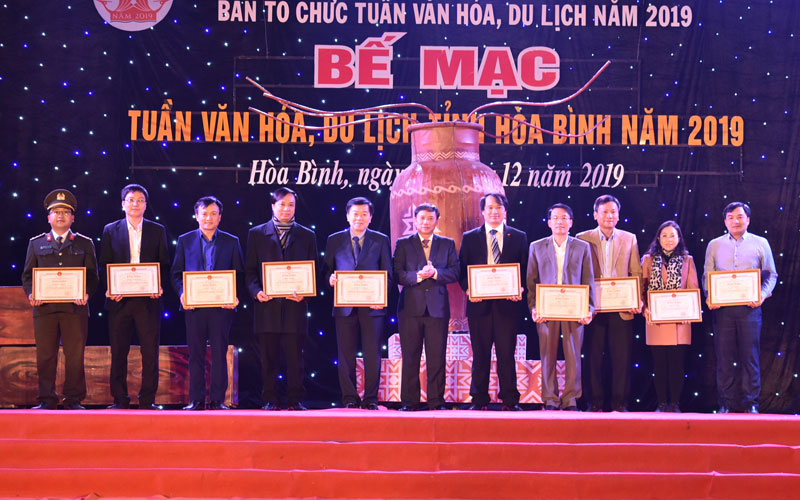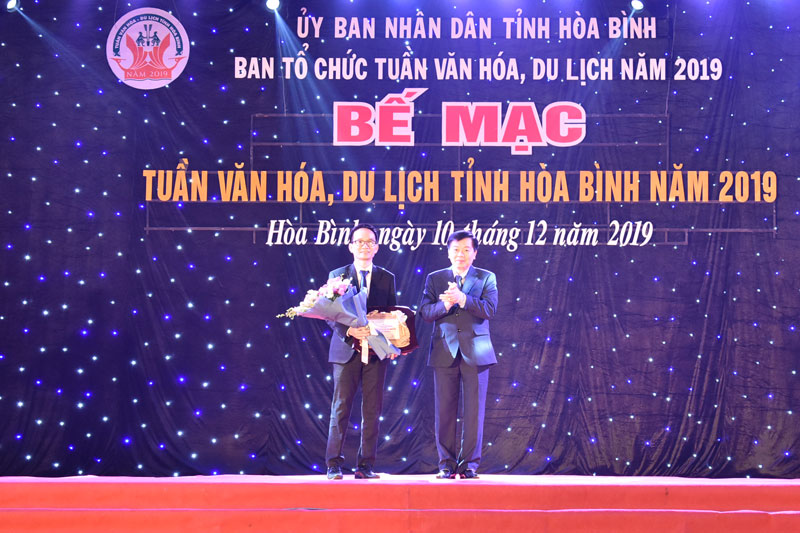


Mr. Bui Van Khanh - the Deputy Secretary of the Provincial Party Committee as well as the Chairman of the Provincial People's Committee, Mr. Nguyen Van Chuong - the Vice Chairman of the Provincial People's Committee as well as the Head of the Organizing Committee of the Week and the leaders from other departments and appropriate authorities and the donors attended the ceremony.

The Week of the provincial Culture and Tourism took place from December 6th to 10th, 2019 with many exciting and unique cultural and tourism activities, leaving good impressions for the local people and tourists and spreading to different regions throughout the country and all over the world.
The program started with the theme "Hoa Binh -The epic region”, which is a special and monumental art program with the participation of professional performers including directors, musicians, choreographers and 200 professional actors, 300 public actors and artisans and more than 100 service staff.
The Festival of Art Photos with the theme "Hoa Binh - the country, the people” with the participation of 25 photographers and 250 works of art photos reflecting vividly about the natural beauty and life of the beautiful homeland of Hoa Binh.
The Food Festival and the show of the traditional craft with many unique food stalls and a number of traditional crafts were presented to show the cultural identity of the ethnic groups living in the province. Especially, the largest and most special food tray displayed on leaves of Muong ethnic people was set a record in Vietnam.
The content of exhibiting and performing the typical Cultural Heritage of the ethnic groups in Hoa Binh province held in Luy Ai hamlet, Phong Phu commune, Tan Lac district has brought the folk music performances imbued with the national identity.
Within the framework of the Week of the Provincial Culture and Tourism, the Beauty Contest of Muong Land has been organized at a provincial scale to seek and honor the outstanding faces representing the traditional beauty of Muong girls for the first time. At the same time, the tourism ambassadors of the province have been found to serve the provincial development of tourism and culture.
During the Week of the Provincial Culture and Tourism, the Workshop on developing Hoa Binh Tourism Products was organized with the participation of more than 30 scientists, managers, travel agencies and hotels. The important ideas and solutions which were researched and drawn from practical practices in the field of tourism have been proposed. At the same time, it is recommended that all levels, sectors and localities build the tourism products in accordance with the direction and strength of the province.
The Week of the provincial Culture and Tourism has been a great success, achieving many goals in terms of introducing and advertising the provincial cultural and tourism features as well as honoring the national cultural values. At the same time, it has been promoting the cooperation, the links, the tour connections, the tourist attraction and promoting the tourism development and so on. Through this event, the province's culture and tourism will spread and resonate, promoting the development of Hoa Binh tourism and cultural products in the coming time.